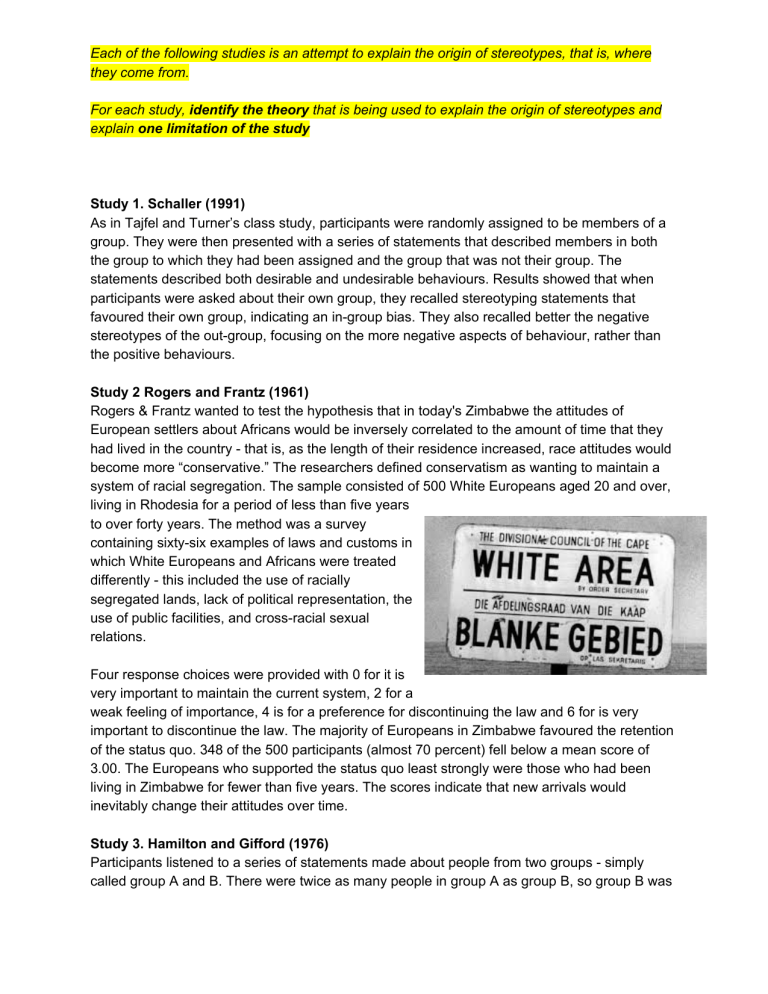Stereotype Origin Studies: Social Identity, Acculturation, Illusory Correlation

Each of the following studies is an attempt to explain the origin of stereotypes, that is, where they come from.
For each study, identify the theory that is being used to explain the origin of stereotypes and explain one limitation of the study
Study 1. Schaller (1991)
As in Tajfel and Turner’s class study, participants were randomly assigned to be members of a group. They were then presented with a series of statements that described members in both the group to which they had been assigned and the group that was not their group. The statements described both desirable and undesirable behaviours. Results showed that when participants were asked about their own group, they recalled stereotyping statements that favoured their own group, indicating an in-group bias. They also recalled better the negative stereotypes of the out-group, focusing on the more negative aspects of behaviour, rather than the positive behaviours.
Study 2 Rogers and Frantz (1961)
Rogers & Frantz wanted to test the hypothesis that in today's Zimbabwe the attitudes of
European settlers about Africans would be inversely correlated to the amount of time that they had lived in the country - that is, as the length of their residence increased, race attitudes would become more “conservative.” The researchers defined conservatism as wanting to maintain a system of racial segregation. The sample consisted of 500 White Europeans aged 20 and over, living in Rhodesia for a period of less than five years to over forty years. The method was a survey containing sixty-six examples of laws and customs in which White Europeans and Africans were treated differently - this included the use of racially segregated lands, lack of political representation, the use of public facilities, and cross-racial sexual relations.
Four response choices were provided with 0 for it is very important to maintain the current system, 2 for a weak feeling of importance, 4 is for a preference for discontinuing the law and 6 for is very important to discontinue the law. The majority of Europeans in Zimbabwe favoured the retention of the status quo. 348 of the 500 participants (almost 70 percent) fell below a mean score of
3.00. The Europeans who supported the status quo least strongly were those who had been living in Zimbabwe for fewer than five years. The scores indicate that new arrivals would inevitably change their attitudes over time.
Study 3. Hamilton and Gifford (1976)
Participants listened to a series of statements made about people from two groups - simply called group A and B. There were twice as many people in group A as group B, so group B was
Each of the following studies is an attempt to explain the origin of stereotypes, that is, where they come from.
For each study, identify the theory that is being used to explain the origin of stereotypes and explain one limitation of the study the minority group. Each statement was about one individual in the group and the statement was either positive or negative. Each group had the same proportion of positive and negative comments. Participants were then asked how many of the people in each group had positive vs. negative traits. They overestimated the number of negative traits in the minority group.
Hamilton & Gifford argued that this was because the minority group was by nature smaller in number, their negative behaviours appeared more distinct and appear to be representative of the group. So, one minority male is caught stealing and it appears to be related to the fact that he is a minority

